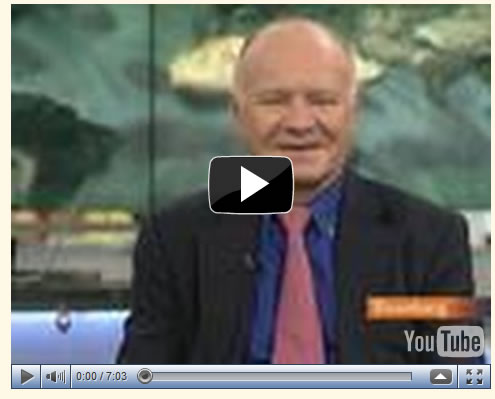Marc Faber, Fed's QE2 Could Trigger stock Market Correction
Stock-Markets / Stock Markets 2010 Oct 30, 2010 - 08:32 AM GMTBy: Dian_L_Chu
 Marc Faber, publisher of the Gloom, Boom & Doom report, discusses the potential impact of further quantitative easing (QE2) by the U.S. Federal Reserve in a Bloomberg interview on Oct. 36 (clip below).
Marc Faber, publisher of the Gloom, Boom & Doom report, discusses the potential impact of further quantitative easing (QE2) by the U.S. Federal Reserve in a Bloomberg interview on Oct. 36 (clip below).
Correction Triggered by QE2?
Faber sees Democrats--"sadly enough"--would get a shot at still retaining the majority, which would mean the monetary and fiscal policy will most likely stay on its current course.
Equity has done well in Sep. and Oct months; however, Faber thinks the markets are stretched in the inflation trade, and weak dollar, high commodity and precious metal prices, along with high equity valuations, all suggest a correction is overdue.
Now, with QE2 being largely priced in, anything less than $1 trillion from the Fed would disappoint the markets and may trigger a correction in U.S. stocks, which could result in more quantitative easing.
But the correction should provide a buying opportunity for investors leading to an up cycle, instead of another bear market.
Equity Better for the Next Decade
Looking at investing for the next ten years, equities, emerging economies in particular, would be a relatively better place to invest than U.S. government bonds, and cash. However, Faber advises against financial, auto, and aircraft. He's been in the high tech sector and likes Microsoft (MSFT).
Precious Metals Due for Pullback
Faber is currently recommending agriculture commodities, and the accumulation of precious metals. On precious metals, he thinks they are overdue for "some kind of correction" by year end, and expect the next leg up in 2011.
Dollar Near An Inflection Point
Faber says dollar is oversold, while in contrast, some of the foreign currencies such as Yen and Franc are overbought. So, an inflection point could be near for a short-term dollar rally which could temporarily push down asset prices.
He warns investors to be very careful about shorting dollar and long assets as the trade has become quite crowded.
Expect a Strong Pullback of Chinese Economy
Although not quite gloom and doom, Faber does expect a "strong pullback" on the Chinese economy due to its many imbalances.
According to Faber, the 0.25% interest rate hike effective Oct. 20 by the PBoC is "meaningless," because of skyrocketing property prices, and the cost of living inflation has gone up much more than the official figure.
He notes food prices have seen high inflation, and because of low GDP per capita where food would account for a high percentage of total expenditure, Faber estimates that the typical consumer inflation rate in countries like China, India, and Vietnam should be around 8 to 18 percent per year.
My Take on China Inflation
The inflation rate in China was last reported at 3.60 percent in September of 2010, climbing at the fastest pace in two years. However, there are some hidden rampant inflation such as 50% on apparel, 20% on food, as reported by BusinessWeek.
Many analysts as well as academics also question how China could have such relatively moderate inflation rate given its double-digit growth and upward pressure on wages. Michael Pettis, a finance professor at Peking University, for example, estimates that "Inflation could well be 6 percent now for most people in China."
There's also another indicator--growth of money supply--which has a proven strong correlation with inflation. China's money supply, M1 and M2, has expanded by 56 percent and 53 percent respectively over the past two years. Currently, with the various tightening measures, both money supply figures are still growing at an annual rate of about 20 percent, based on Bloomberg data.
Furthermore, the continuing massive rural-to-urban migration will likely keep pushing up rents and food prices, just to name two of the many categories, and wages are expected to rise around 8 percent this year.
As consumer inflation is typically a lagging indicator, China may experience continuing higher CPI. That means Beijing is facing an increasingly difficult task of containing inflation, while maintaining sufficient growth to prevent a mass civil unrest. As such, there will likely be more tightening, which would put the markets on a few roller coaster rides in the next two years or so.
Nevertheless, since Chinese policymakers are keeping a close inflation watch, and are already taking actions (which is the key), I believe China is heading towards more sustainable growth. And if China is "on a treadmill to hell" as Jim Chanos says, you can bet that the United States will be dragged along for the ride as well.
Dian L. Chu, M.B.A., C.P.M. and Chartered Economist, is a market analyst and financial writer regularly contributing to Seeking Alpha, Zero Hedge, and other major investment websites. Ms. Chu has been syndicated to Reuters, USA Today, NPR, and BusinessWeek. She blogs at Economic Forecasts & Opinions.
© 2010 Copyright Dian L. Chu - All Rights Reserved Disclaimer: The above is a matter of opinion provided for general information purposes only and is not intended as investment advice. Information and analysis above are derived from sources and utilising methods believed to be reliable, but we cannot accept responsibility for any losses you may incur as a result of this analysis. Individuals should consult with their personal financial advisors.
© 2005-2022 http://www.MarketOracle.co.uk - The Market Oracle is a FREE Daily Financial Markets Analysis & Forecasting online publication.




